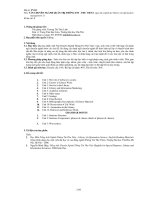anh văn chuyên ngành dược 2 unit 5
Bạn đang xem bản rút gọn của tài liệu. Xem và tải ngay bản đầy đủ của tài liệu tại đây (1.59 MB, 14 trang )
QUESTION 1: WHAT IS THE DIFFERENCE BETWEEN
DRUG SAFETY DEPARTMENT AND REGULATORY
AFFAIRS?
Drug Safety department
Regulatory Affairs department
Reporting an adverse drug
reaction to health authorities
Submitting documents needed
to obtain marketing approval
for a drug
Monitoring and evaluating
suspected side effects
Compiling dossiers for
submission to authorities
Responding to a
physician's report
Writing the drug information
for the patient
HELLO!
We are group 7
QUESTION 2: WHY DO HEALTHCARE PROFESSIONALS
AND PHARMACEUTICAL COMPANIES KEEP RECORDS
OF UNEXPECTED REACTIONS TO DRUGS?
Because healthcare
professionals and
pharmaceutical companies work
together to research, monitor
and evaluate suspected side
effects to improve the safety of
drugs in use, minimize adverse
effects
QUESTION 2: HOW MUCH SHOULD PATIENTS KNOW
ABOUT POSSIBLE SIDE EFFECTS BEFORE TAKING
MEDICATION?
The patient should be known
about all of possible side effects
before taking medication
THANK!
See you later
QUESTION 3: WHAT IS
PHARMACOVIGILANCE?
Pharmacovigilance (PV) is
defined as the science and
activities relating to the
detection, assessment,
understanding and
prevention of adverse
effects or any other drugrelated problem
QUESTION 3: WHICH AGENCIES ARE RELATED TO
PHARMACOVIGILANCE? WHAT ARE THEIR ROLES?
Government agencies,
Pharmaceutical
companies, and Healthcare
professionals work together
to monitor and evaluate
suspected side effects of
medicines to improve the
safety of drugs in use
QUESTION 4: WHAT IS THE DIFFERENCE AMONG SIDE
EFFECT, ADVERSE EFFECT
Side effects
Any unintended reaction caused by
a drug or medical treatment
They are known or can be
determined
They happen based on medication
alone and no need of treatment
Adverse effects
is an undesired harmful effect
resulting from a medication or
other intervention such as
surgery
They are unexpected and hard to
determine.
They happen due to incorrect
dosage or surgery and require
treatment
QUESTION 4: WHAT IS THE DIFFERENCE AMONG ADVERSE
EVENT AND SERIOUS ADVERSE EVENT
Adverse
event
an unwanted medical occurrence
which a patient experiences during
treatment. This may or may not be
a side effect of a drug
This may or may not be a
side effect of a drug
easily tolerated and are of minor
irritant type, interfere or interrupt
the patient’s normal daily activities
Serious adverse event
(SAE)
an adverse event that threatens
life, requires or prolongs
hospitalization, or results in death
any untoward medical
occurrence that at any dose
Death, Life-threatening,
Hospitalization, Congenital
anomaly, Impairment, damage or
disruption in the patient's body
function
QUESTION 5: WHAT IS FAKE DRUGS
Counterfeit medicines are manufactured in one of the
following cases:
A worthless placebo
A lower concentration of the same active
ingredient
A similar, but different substance
A totally different, potentially dangerous
substance
QUESTION 5: HOW DO FAKE DRUGS
AFFECT US?
01
02
Treatment failure and even death can result with
the use of counterfeit drugs
End organ damage: Ingestion of counterfeit drugs
can result in damage to the liver, kidneys, heart and
the central nervous system
03
04
Loss of confidence: The reputation of the original
product is damaged. Patients may lose confidence in the
health care professionals.
Economic loss: Many pharmaceutical companies lose
large amounts of money because their products are
being counterfeited and sold at cheaper rates.
QUESTION 6: DISTINGUISH PIL AND PILL
PILs
The Patient Information
Leaflets (PILs) are the
leaflets containing specific
information about medical
conditions, doses, side
effects that packed with
medicines to give the user
information about product
Pill
s
Pills were powdered drugs
that featured the active
ingredients mixed with
adhesive substances to
create small dosage forms
for oral administration
QUESTION 6: DISTINGUISH PIL AND PILL
The Patient Information Leaflets (PILs)
Pills
QUESTION 7: READ THE DOCTOR’S REPORT
IN PART 1
What were the patient’s symptoms before she was admitted to
hospital?
Faint, severe skin rash and inflammation, lost consiousness
How was she treated by her physician?
Mensamint was discontinued, a strong sedative was
administered to reduce the symptoms
What was her condition when she was discharged from the
hospital?
All symptoms except for a mild skin irritation had subsided









